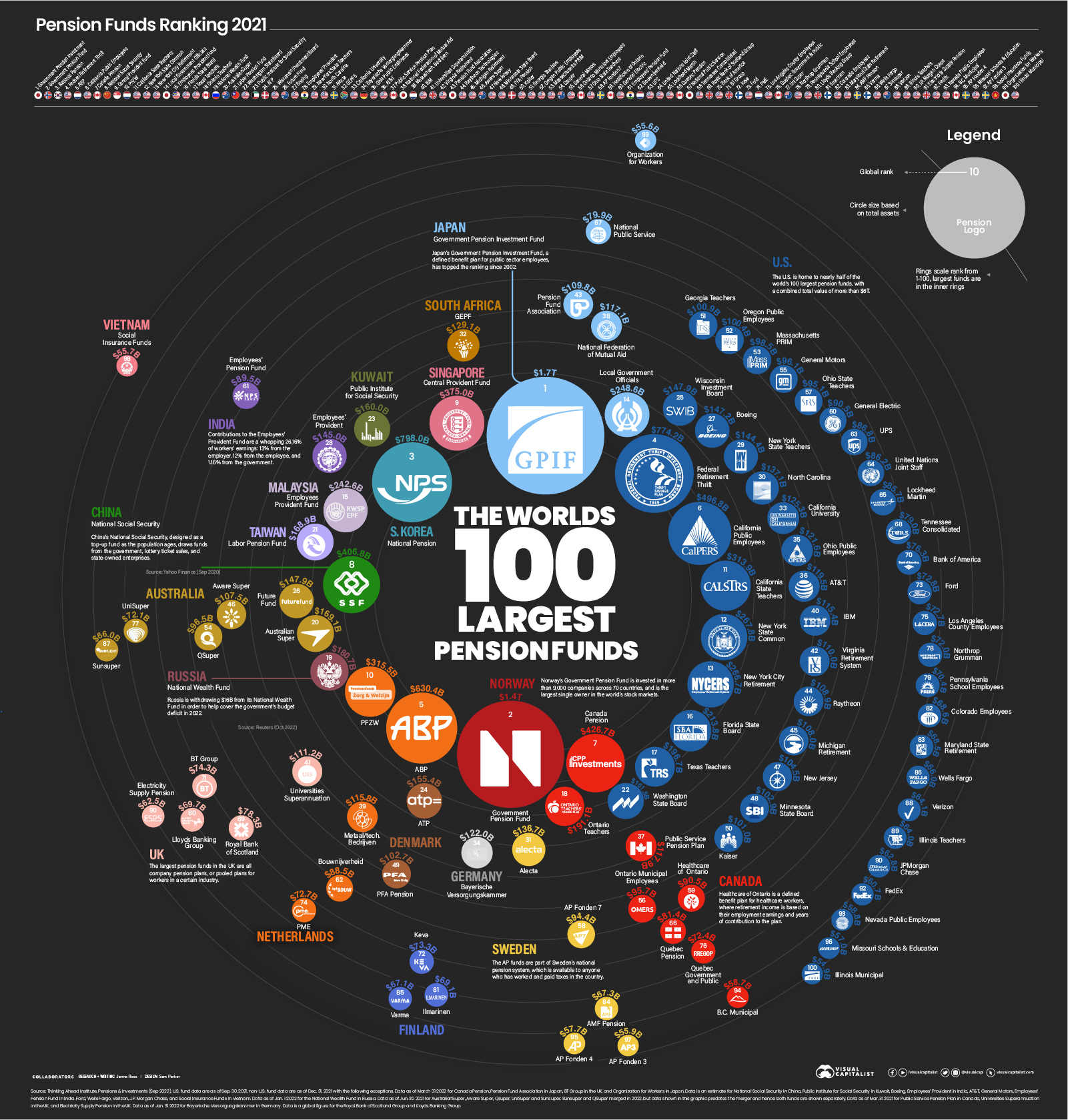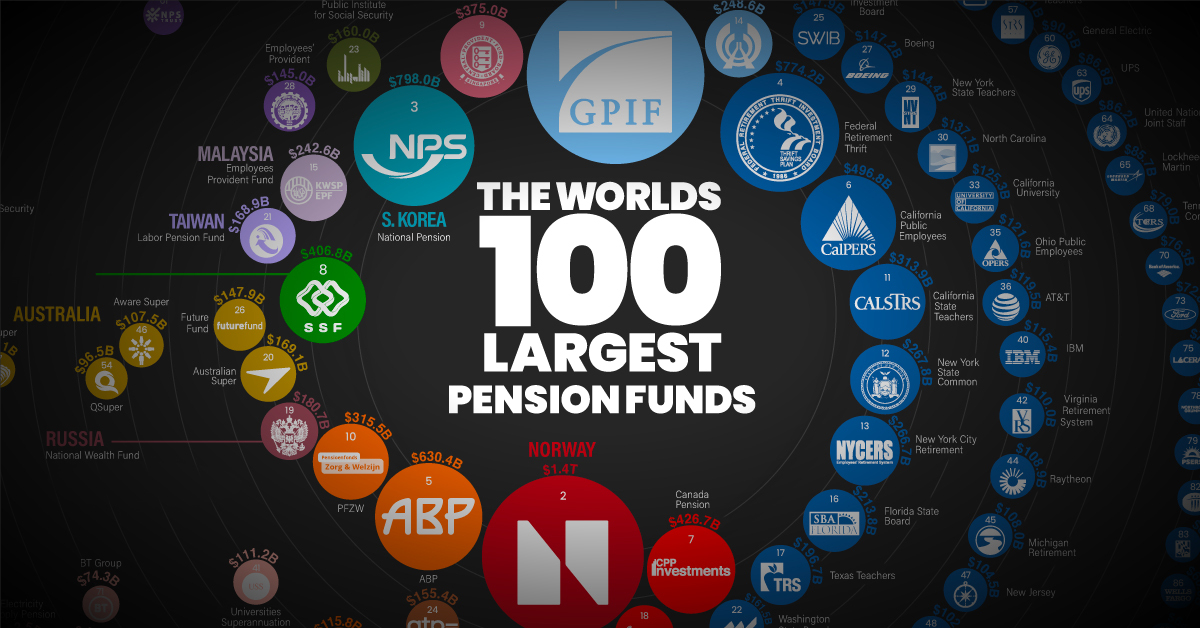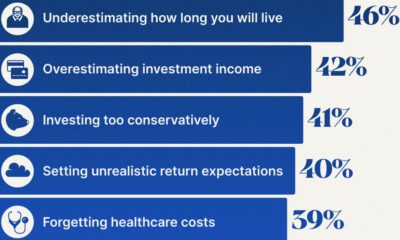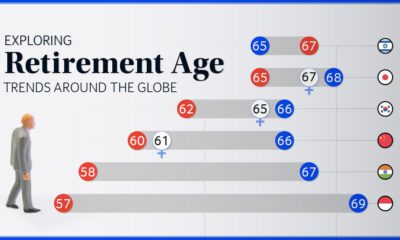Markets
Ranked: The World’s 100 Biggest Pension Funds
View the full-resolution version of this infographic
Ranked: The World’s 100 Biggest Pension Funds
View the high-resolution of the infographic by clicking here.
Despite economic uncertainty, pension funds saw relatively strong growth in 2021. The world’s 100 biggest pension funds are worth over $17 trillion in total, an increase of 8.5% over the previous year.
This graphic uses data from the Thinking Ahead Institute to rank the world’s biggest pension funds, and where they are located.
What is a Pension Fund?
A pension fund is a fund that is designed to provide retirement income. This ranking covers four different types:
- Sovereign funds: Funds controlled directly by the state. This ranking only includes sovereign funds that are established by national authorities.
- Public sector funds: Funds that cover public sector workers, such as government employees and teachers, in provincial or state sponsored plans.
- Private independent funds: Funds controlled by private sector organizations that are authorized to manage pension plans from different employers.
- Corporate funds: Funds that cover workers in company sponsored pension plans.
Among the largest funds, public sector funds are the most common.
The Largest Pension Funds, Ranked
Here are the top 100 pension funds, organized from largest to smallest.
| Rank | Fund | Market | Total Assets |
|---|---|---|---|
| 1 | Government Pension Investment Fund | 🇯🇵 Japan | $1.7T |
| 2 | Government Pension Fund | 🇳🇴 Norway | $1.4T |
| 3 | National Pension | 🇰🇷 South Korea | $798.0B |
| 4 | Federal Retirement Thrift | 🇺🇸 U.S. | $774.2B |
| 5 | ABP | 🇳🇱 Netherlands | $630.4B |
| 6 | California Public Employees | 🇺🇸 U.S. | $496.8B |
| 7 | Canada Pension | 🇨🇦 Canada | $426.7B |
| 8 | National Social Security | 🇨🇳 China | $406.8B |
| 9 | Central Provident Fund | 🇸🇬 Singapore | $375.0B |
| 10 | PFZW | 🇳🇱 Netherlands | $315.5B |
| 11 | California State Teachers | 🇺🇸 U.S. | $313.9B |
| 12 | New York State Common | 🇺🇸 U.S. | $267.8B |
| 13 | New York City Retirement | 🇺🇸 U.S. | $266.7B |
| 14 | Local Government Officials | 🇯🇵 Japan | $248.6B |
| 15 | Employees Provident Fund | 🇲🇾 Malaysia | $242.6B |
| 16 | Florida State Board | 🇺🇸 U.S. | $213.8B |
| 17 | Texas Teachers | 🇺🇸 U.S. | $196.7B |
| 18 | Ontario Teachers | 🇨🇦 Canada | $191.1B |
| 19 | National Wealth Fund | 🇷🇺 Russia | $180.7B |
| 20 | AustralianSuper | 🇦🇺 Australia | $169.1B |
| 21 | Labor Pension Fund | 🇹🇼 Taiwan | $168.9B |
| 22 | Washington State Board | 🇺🇸 U.S. | $161.5B |
| 23 | Public Institute for Social Security | 🇰🇼 Kuwait | $160.0B |
| 24 | ATP | 🇩🇰 Denmark | $155.4B |
| 25 | Wisconsin Investment Board | 🇺🇸 U.S. | $147.9B |
| 26 | Future Fund | 🇦🇺 Australia | $147.9B |
| 27 | Boeing | 🇺🇸 U.S. | $147.2B |
| 28 | Employees' Provident | 🇮🇳 India | $145.0B |
| 29 | New York State Teachers | 🇺🇸 U.S. | $144.4B |
| 30 | North Carolina | 🇺🇸 U.S. | $137.1B |
| 31 | Alecta | 🇸🇪 Sweden | $136.7B |
| 32 | GEPF | 🇿🇦 South Africa | $129.1B |
| 33 | California University | 🇺🇸 U.S. | $125.3B |
| 34 | Bayerische Versorgungskammer | 🇩🇪 Germany | $122.0B |
| 35 | Ohio Public Employees | 🇺🇸 U.S. | $121.6B |
| 36 | AT&T | 🇺🇸 U.S. | $119.5B |
| 37 | Public Service Pension Plan | 🇨🇦 Canada | $117.9B |
| 38 | National Federation of Mutual Aid | 🇯🇵 Japan | $117.1B |
| 39 | Metaal/tech. Bedrijven | 🇳🇱 Netherlands | $115.8B |
| 40 | IBM | 🇺🇸 U.S. | $115.4B |
| 41 | Universities Superannuation | 🇬🇧 UK | $111.2B |
| 42 | Virginia Retirement | 🇺🇸 U.S. | $110.0B |
| 43 | Pension Fund Association | 🇯🇵 Japan | $109.8B |
| 44 | Raytheon Technologies | 🇺🇸 U.S. | $108.9B |
| 45 | Michigan Retirement | 🇺🇸 U.S. | $108.0B |
| 46 | Aware Super | 🇦🇺 Australia | $107.5B |
| 47 | New Jersey | 🇺🇸 U.S. | $104.5B |
| 48 | Minnesota State Board | 🇺🇸 U.S. | $102.9B |
| 49 | PFA Pension | 🇩🇰 Denmark | $102.7B |
| 50 | Kaiser | 🇺🇸 U.S. | $101.0B |
| 51 | Georgia Teachers | 🇺🇸 U.S. | $100.9B |
| 52 | Oregon Public Employees | 🇺🇸 U.S. | $100.4B |
| 53 | Massachusetts PRIM | 🇺🇸 U.S. | $98.5B |
| 54 | Qsuper | 🇦🇺 Australia | $96.5B |
| 55 | General Motors | 🇺🇸 U.S. | $96.1B |
| 56 | Ontario Municipal Employees | 🇨🇦 Canada | $95.7B |
| 57 | Ohio State Teachers | 🇺🇸 U.S. | $95.1B |
| 58 | AP Fonden 7 | 🇸🇪 Sweden | $94.4B |
| 59 | Healthcare of Ontario | 🇨🇦 Canada | $90.5B |
| 60 | General Electric | 🇺🇸 U.S. | $90.5B |
| 61 | Employees' Pension Fund | 🇮🇳 India | $89.5B |
| 62 | Bouwnijverheid | 🇳🇱 Netherlands | $88.5B |
| 63 | UPS | 🇺🇸 U.S. | $86.8B |
| 64 | United Nations Joint Staff | 🇺🇸 U.S. | $86.2B |
| 65 | Lockheed Martin | 🇺🇸 U.S. | $85.7B |
| 66 | Quebec Pension | 🇨🇦 Canada | $81.4B |
| 67 | National Public Service | 🇯🇵 Japan | $79.9B |
| 68 | Tennessee Consolidated | 🇺🇸 U.S. | $79.0B |
| 69 | Royal Bank of Scotland Group | 🇬🇧 UK | $78.3B |
| 70 | Bank of America | 🇺🇸 U.S. | $76.3B |
| 71 | BT Group | 🇬🇧 UK | $74.3B |
| 72 | Keva | 🇫🇮 Finland | $73.3B |
| 73 | Ford | 🇺🇸 U.S. | $72.8B |
| 74 | PME | 🇳🇱 Netherlands | $72.7B |
| 75 | Los Angeles County Employees | 🇺🇸 U.S. | $72.7B |
| 76 | Quebec Government & Public | 🇨🇦 Canada | $72.4B |
| 77 | UniSuper | 🇦🇺 Australia | $72.1B |
| 78 | Northrop Grumman | 🇺🇸 U.S. | $72.0B |
| 79 | Pennsylvania School Employees | 🇺🇸 U.S. | $70.4B |
| 80 | Lloyds Banking Group | 🇬🇧 UK | $69.7B |
| 81 | Ilmarinen | 🇫🇮 Finland | $69.1B |
| 82 | Colorado Employees | 🇺🇸 U.S. | $68.6B |
| 83 | Maryland State Retirement | 🇺🇸 U.S. | $68.5B |
| 84 | AMF Pension | 🇸🇪 Sweden | $67.3B |
| 85 | Varma | 🇫🇮 Finland | $67.1B |
| 86 | Wells Fargo | 🇺🇸 U.S. | $66.0B |
| 87 | Sunsuper | 🇦🇺 Australia | $66.0B |
| 88 | Verizon | 🇺🇸 U.S. | $64.1B |
| 89 | Illinois Teachers | 🇺🇸 U.S. | $64.0B |
| 90 | J.P. Morgan Chase | 🇺🇸 U.S. | $62.8B |
| 91 | Electricity Supply Pension | 🇬🇧 UK | $62.5B |
| 92 | FedEx | 🇺🇸 U.S. | $60.7B |
| 93 | Nevada Public Employees | 🇺🇸 U.S. | $58.8B |
| 94 | B.C. Municipal | 🇨🇦 Canada | $58.7B |
| 95 | AP Fonden 4 | 🇸🇪 Sweden | $57.7B |
| 96 | Missouri Schools & Education | 🇺🇸 U.S. | $57.0B |
| 97 | AP Fonden 3 | 🇸🇪 Sweden | $55.9B |
| 98 | Social Insurance Funds | 🇻🇳 Vietnam | $55.7B |
| 99 | Organization for Workers | 🇯🇵 Japan | $55.6B |
| 100 | Illinois Municipal | 🇺🇸 U.S. | $54.9B |
U.S. fund data are as of Sep. 30, 2021, and non-U.S. fund data are as of Dec. 31, 2021. There are some exceptions as noted in the graphic footnotes.
Japan’s Government Pension Investment Fund (GPIF) is the largest in the ranking for the 21st year in a row. For a time, the fund was the largest holder of domestic stocks in Japan, though the Bank of Japan has since taken that title. Given its enormous size, investors closely follow the GPIF’s actions. For instance, the fund made headlines for deciding to start investing in startups, because the move could entice other pensions to make similar investments.
America is home to 47 funds on the list, including the largest public sector fund: the Thrift Savings Plan (TSP), overseen by the Federal Retirement Thrift Investment Board. Because of its large financial influence, both political parties have been accused of using it as a political tool. Democrats have pushed to divest assets in fossil fuel companies, while Republicans have proposed blocking investment in Chinese-owned companies.
Russia’s National Wealth Fund comes in at number 19 on the list. The fund is designed to support the public pension system and help balance the budget as needed. With Russia’s economy facing difficulties amid the Russia-Ukraine conflict, the government has also used it as a rainy day fund. For instance, Russia has set aside $23 billion from the fund to replace foreign aircraft with domestic models, because Western sanctions have made it difficult to source replacement parts for foreign planes.
The Future of Pension Funds
The biggest pension funds can have a large influence in the market because of their size. Of course, they are also responsible for providing retirement income to millions of people. Pension funds face a variety of challenges in order to reach their goals:
- Geopolitical conflict creates volatility and uncertainty
- High inflation and low interest rates (relative to long-term averages) limit return potential
- Aging populations mean more withdrawals and less fund contributions
Some pension funds are turning to alternative assets, such as private equity, in pursuit of more diversification and higher returns. Of course, these investments can also carry more risk.
Ontario Teachers’ Pension Plan, number 18 on the list, invested $95 million in the now-bankrupt cryptocurrency exchange FTX. The plan made the investment through its venture growth platform, to “gain small-scale exposure to an emerging area in the financial technology sector.”
In this case, the investment’s failure is expected to have a minimal impact given it only made up 0.05% of the plan’s net assets. However, it does highlight the challenges pension funds face to generate sufficient returns in a variety of macroeconomic environments.
Markets
The European Stock Market: Attractive Valuations Offer Opportunities
On average, the European stock market has valuations that are nearly 50% lower than U.S. valuations. But how can you access the market?

European Stock Market: Attractive Valuations Offer Opportunities
Europe is known for some established brands, from L’Oréal to Louis Vuitton. However, the European stock market offers additional opportunities that may be lesser known.
The above infographic, sponsored by STOXX, outlines why investors may want to consider European stocks.
Attractive Valuations
Compared to most North American and Asian markets, European stocks offer lower or comparable valuations.
| Index | Price-to-Earnings Ratio | Price-to-Book Ratio |
|---|---|---|
| EURO STOXX 50 | 14.9 | 2.2 |
| STOXX Europe 600 | 14.4 | 2 |
| U.S. | 25.9 | 4.7 |
| Canada | 16.1 | 1.8 |
| Japan | 15.4 | 1.6 |
| Asia Pacific ex. China | 17.1 | 1.8 |
Data as of February 29, 2024. See graphic for full index names. Ratios based on trailing 12 month financials. The price to earnings ratio excludes companies with negative earnings.
On average, European valuations are nearly 50% lower than U.S. valuations, potentially offering an affordable entry point for investors.
Research also shows that lower price ratios have historically led to higher long-term returns.
Market Movements Not Closely Connected
Over the last decade, the European stock market had low-to-moderate correlation with North American and Asian equities.
The below chart shows correlations from February 2014 to February 2024. A value closer to zero indicates low correlation, while a value of one would indicate that two regions are moving in perfect unison.
| EURO STOXX 50 | STOXX EUROPE 600 | U.S. | Canada | Japan | Asia Pacific ex. China |
|
|---|---|---|---|---|---|---|
| EURO STOXX 50 | 1.00 | 0.97 | 0.55 | 0.67 | 0.24 | 0.43 |
| STOXX EUROPE 600 | 1.00 | 0.56 | 0.71 | 0.28 | 0.48 | |
| U.S. | 1.00 | 0.73 | 0.12 | 0.25 | ||
| Canada | 1.00 | 0.22 | 0.40 | |||
| Japan | 1.00 | 0.88 | ||||
| Asia Pacific ex. China | 1.00 |
Data is based on daily USD returns.
European equities had relatively independent market movements from North American and Asian markets. One contributing factor could be the differing sector weights in each market. For instance, technology makes up a quarter of the U.S. market, but health care and industrials dominate the broader European market.
Ultimately, European equities can enhance portfolio diversification and have the potential to mitigate risk for investors.
Tracking the Market
For investors interested in European equities, STOXX offers a variety of flagship indices:
| Index | Description | Market Cap |
|---|---|---|
| STOXX Europe 600 | Pan-regional, broad market | €10.5T |
| STOXX Developed Europe | Pan-regional, broad-market | €9.9T |
| STOXX Europe 600 ESG-X | Pan-regional, broad market, sustainability focus | €9.7T |
| STOXX Europe 50 | Pan-regional, blue-chip | €5.1T |
| EURO STOXX 50 | Eurozone, blue-chip | €3.5T |
Data is as of February 29, 2024. Market cap is free float, which represents the shares that are readily available for public trading on stock exchanges.
The EURO STOXX 50 tracks the Eurozone’s biggest and most traded companies. It also underlies one of the world’s largest ranges of ETFs and mutual funds. As of November 2023, there were €27.3 billion in ETFs and €23.5B in mutual fund assets under management tracking the index.
“For the past 25 years, the EURO STOXX 50 has served as an accurate, reliable and tradable representation of the Eurozone equity market.”
— Axel Lomholt, General Manager at STOXX
Partnering with STOXX to Track the European Stock Market
Are you interested in European equities? STOXX can be a valuable partner:
- Comprehensive, liquid and investable ecosystem
- European heritage, global reach
- Highly sophisticated customization capabilities
- Open architecture approach to using data
- Close partnerships with clients
- Part of ISS STOXX and Deutsche Börse Group
With a full suite of indices, STOXX can help you benchmark against the European stock market.

Learn how STOXX’s European indices offer liquid and effective market access.

-

 Economy2 days ago
Economy2 days agoEconomic Growth Forecasts for G7 and BRICS Countries in 2024
The IMF has released its economic growth forecasts for 2024. How do the G7 and BRICS countries compare?
-

 Markets1 week ago
Markets1 week agoU.S. Debt Interest Payments Reach $1 Trillion
U.S. debt interest payments have surged past the $1 trillion dollar mark, amid high interest rates and an ever-expanding debt burden.
-

 United States2 weeks ago
United States2 weeks agoRanked: The Largest U.S. Corporations by Number of Employees
We visualized the top U.S. companies by employees, revealing the massive scale of retailers like Walmart, Target, and Home Depot.
-

 Markets2 weeks ago
Markets2 weeks agoThe Top 10 States by Real GDP Growth in 2023
This graphic shows the states with the highest real GDP growth rate in 2023, largely propelled by the oil and gas boom.
-

 Markets2 weeks ago
Markets2 weeks agoRanked: The World’s Top Flight Routes, by Revenue
In this graphic, we show the highest earning flight routes globally as air travel continued to rebound in 2023.
-

 Markets3 weeks ago
Markets3 weeks agoRanked: The Most Valuable Housing Markets in America
The U.S. residential real estate market is worth a staggering $47.5 trillion. Here are the most valuable housing markets in the country.
-

 Debt1 week ago
Debt1 week agoHow Debt-to-GDP Ratios Have Changed Since 2000
-

 Markets2 weeks ago
Markets2 weeks agoRanked: The World’s Top Flight Routes, by Revenue
-

 Countries2 weeks ago
Countries2 weeks agoPopulation Projections: The World’s 6 Largest Countries in 2075
-

 Markets2 weeks ago
Markets2 weeks agoThe Top 10 States by Real GDP Growth in 2023
-

 Demographics2 weeks ago
Demographics2 weeks agoThe Smallest Gender Wage Gaps in OECD Countries
-

 United States2 weeks ago
United States2 weeks agoWhere U.S. Inflation Hit the Hardest in March 2024
-

 Green2 weeks ago
Green2 weeks agoTop Countries By Forest Growth Since 2001
-

 United States2 weeks ago
United States2 weeks agoRanked: The Largest U.S. Corporations by Number of Employees




















